Gas Separation Membrane Market
Gas Separation Membrane Market Size and Share Forecast Outlook 2025 to 2035
Gas separation membrane market is projected to grow from USD 1.6 billion in 2025 to USD 3.1 billion by 2035, at a CAGR of 6.8%. Polymeric Membranes will dominate with a 73.5% market share, while nitrogen separation will lead the application segment with a 41.6% share.
Gas Separation Membrane Market Forecast and Outlook 2025 to 2035
The global gas separation membrane market is set to grow from USD 1.6 billion in 2025 to USD 3.1 billion by 2035, adding USD 1.6 billion in new revenue and advancing at a CAGR of 6.8%. Growth is driven by escalating demand for industrial gas purification solutions, expanding petrochemical processing infrastructure across developed and emerging markets, and accelerating energy efficiency requirements among industrial organizations seeking cost-effective separation technologies.
Quick Stats for Gas Separation Membrane Market
- Gas Separation Membrane Market Value (2025): USD 1.6 billion
- Gas Separation Membrane Market Forecast Value (2035): USD 3.1 billion
- Gas Separation Membrane Market Forecast CAGR: 6.8%
- Leading Product in Gas Separation Membrane Market: Polymeric Membranes (73.5%)
- Key Growth Regions in Gas Separation Membrane Market: Asia Pacific, North America, and Middle East & Africa
- Top Players in Gas Separation Membrane Market: Air Products and Chemicals Inc., Air Liquide, Advanced Separations, Atlas Copco AB, DIC Corporation
- Where revenue comes from - Now Vs Next (Industry-level view)
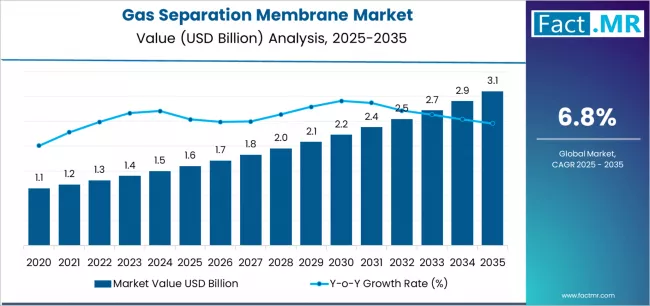
Gas separation membrane technologies are increasingly recognized as essential tools for process engineering practitioners, offering precise gas purification capabilities, energy consumption reduction assurance, and comprehensive operational efficiency characteristics compared to traditional cryogenic distillation approaches.
Polymeric membrane formulations dominate the market, favored in industrial and petrochemical environments for their established selectivity properties, providing cost-effective separation mechanisms, scalable module configurations, and commercial acceptance across diverse gas processing applications and industrial demographics.
Polymeric membrane products remain fundamental in separation protocols where nitrogen generation and acid gas removal match operational requirements and process efficiency standards. Petrochemicals and oil & gas sectors are advancing among end-use categories as specialized processing facility networks expand and gas treatment infrastructure increases accessibility in production-convenient locations with comprehensive separation structures.
Geographic concentration demonstrates dynamic growth patterns with India and China leading expansion, supported by rising petrochemical manufacturing capacity, industrial gas consciousness expansion among processing populations, and membrane system establishment programs in production centers.
USA, Saudi Arabia, Brazil, Germany, and Japan demonstrate robust development through established industrial ecosystems, regulatory framework maturity for emission control applications, and standardized acceptance of membrane separation procedures. Competitive advantage is consolidating around separation efficiency profiles, membrane durability documentation, process integration compatibility, and comprehensive gas treatment portfolios rather than standalone membrane formulations alone.
The first half of the decade will witness the market climbing from USD 1.6 billion to approximately USD 2.2 billion, adding USD 0.6 billion in value, which constitutes 40% of the total forecast growth period. This phase will be characterized by the continued dominance of polymeric membrane methodologies in industrial settings, combined with accelerating adoption of nitrogen separation technologies in food packaging applications where product preservation validation and atmospheric control create favorable quality outcomes.
The latter half will witness sustained expansion from USD 2.2 billion to USD 3.1 billion, representing an addition of USD 0.9 billion or 60% of the decade's growth, defined by broadening acceptance of acid gas separation protocols and integration of hybrid membrane systems across mainstream petrochemical processing facilities.
| Period | Primary Revenue Buckets | Share | Notes |
|---|---|---|---|
| Today | Polymeric Membranes | 73.5% | Product dominance |
| Nitrogen Separation | 41.6% | Application leadership | |
| Petrochemicals & Oil/Gas | 39.2% | Primary end-use sector | |
| Hollow Fiber Modules | 48-54% | Configuration preference | |
| Onsite Generation | 36-42% | Deployment model | |
| Future (3-5 yrs) | Inorganic Membranes | 28-34% | Advanced material growth |
| Hydrogen Separation | 32-38% | Clean energy momentum | |
| Mixed Matrix Membranes | 26-32% | Hybrid technology | |
| Carbon Capture | 30-36% | Sustainability applications | |
| Pharmaceuticals | 24-30% | High-purity demand | |
| Modular Systems | 28-34% | Scalable deployment | |
| Biogas Upgrading | 22-28% | Renewable gas treatment |
Gas Separation Membrane Market Key Takeaways
At-a-Glance Metrics
| Metric | Value |
|---|---|
| Market Value (2025) → | USD 1.6 billion |
| Market Forecast (2035) ↑ | USD 3.1 billion |
| Growth Rate ★ | 6.8% CAGR |
| Leading Product → | Polymeric Membranes |
| Primary Application → | Nitrogen Separation |
The market demonstrates exceptional fundamentals with Polymeric Membranes capturing a commanding 73.5% share through superior cost-effectiveness characteristics, established manufacturing advantages, and proven selectivity profiles across industrial separation applications. Nitrogen Separation drives primary application demand at 41.6% share, supported by established food preservation infrastructure and inert atmosphere requirements that maintain operational compliance across diverse industrial segments.
Geographic concentration remains anchored in Asia Pacific with emerging market leadership through petrochemical manufacturing expansion and industrial gas infrastructure development, while developed markets show accelerated adoption rates driven by emission control demographics and process optimization preferences.
Imperatives for Stakeholders in Gas Separation Membrane Market
Design for selectivity and durability, not just gas permeation
- Offer complete separation solutions: advanced membrane modules + process integration support + system optimization tools + performance monitoring systems + maintenance platforms.
- Preconfigured separation packages: nitrogen generation specifications, acid gas removal configurations, hydrogen recovery programs, and combination purification protocols for diverse industrial requirements.
Performance readiness for industrial applications
- Comprehensive selectivity documentation, operational validation systems, and reliability infrastructure (fouling resistance, chemical compatibility, thermal stability protocols).
Affordability-by-design approach
- Cost-optimized membrane portfolios, flexible system pricing models, industrial loyalty programs, and transparent total ownership cost documentation.
Engineering training-focused market penetration
- Established process integration workshops + comprehensive certification programs (membrane selection, system design, troubleshooting management); direct engineer engagement for relationship development and operational confidence building.
Segmental Analysis
The market segments by product into polymeric membranes, inorganic membranes, and metallic membranes, representing the evolution from basic gas separation toward sophisticated selective permeation with advanced material capabilities, comprehensive durability, and integrated performance characteristics.
The application segmentation divides the market into nitrogen separation (41.6%) with food packaging, inerting, and blanketing applications, acid gas separation (27.4%), oxygen separation, hydrogen separation, and other uses, reflecting distinct purification objectives for atmospheric control and product preservation versus carbon dioxide removal and natural gas treatment implementation.
The end-use segmentation shows petrochemicals and oil & gas commanding 39.2% position, followed by chemicals (21.1%), food and beverage, power generation, pharmaceuticals, pollution control, and other sectors, demonstrating varied industrial specialization levels and separation technology concentrations.
What Makes Polymeric Membranes Command the Largest Share in the Gas Separation Membrane Market?
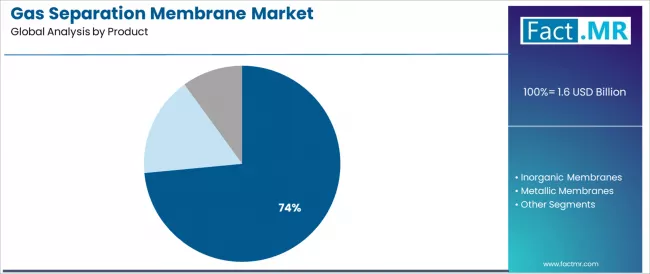
Polymeric membranes command the leading position in the gas separation membrane market with a 73.5% market share through superior commercial viability characteristics, including established manufacturing scalability, extensive application documentation, and standardized module configurations that enable process engineers to achieve predictable separation outcomes across varied industrial categories and diverse processing demographics.
The segment benefits from cost-effectiveness advantages through economical material production, proven operational reliability without excessive maintenance requirements, and established fabrication technique documentation without requiring specialized processing equipment. Advanced polymer technology enables selectivity optimization, permeability enhancement, and module design customization, where separation efficiency and operational flexibility represent critical process requirements.
Hollow fiber module configurations hold significant share within the polymeric segment, appealing to engineers seeking high surface area capabilities for compact nitrogen generation systems. Polymeric membranes differentiate through proven commercial acceptance profiles, process engineer familiarity advantages, and integration with established industrial protocols that enhance deployment confidence while maintaining compliant separation outcomes for diverse gas purification applications.
Key market characteristics:
- Advanced selectivity properties with gas-pair separation capabilities and permeability optimization for efficient purification
- Superior manufacturing documentation, enabling module standardization and cost-effective production readiness for industrial applications
- Comprehensive engineer acceptance, including process design integration and application guideline inclusion for global market applications
Why do Inorganic Membranes Represent a High-performance Separation Segment?
Inorganic membranes maintain specialized market position with 18.8% share through advanced material characteristics and extreme condition capabilities. These products appeal to chemical processors and refiners seeking comprehensive thermal stability with harsh environment resistance, offering ceramic and zeolite-based separation patterns and durability approaches through inorganic material systems. Market adoption is driven by high-temperature applications, emphasizing complete chemical resistance and long-term stability optimization through advanced material mechanisms.
Which Application Area is the Dominant Category in the Market?
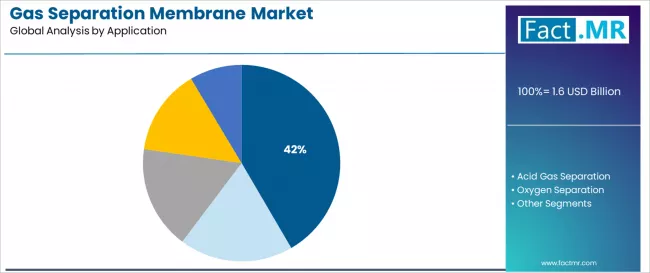
Nitrogen separation demonstrates application leadership in the gas separation membrane market with a 41.6% share due to widespread industrial demand requirements and established focus on inert atmosphere generation, food preservation protocols, and blanketing applications that maximize product quality while maintaining consistent operational safety characteristics.
Industrial operators prioritize nitrogen separation for food packaging preservation, chemical process inerting, and integration with manufacturing safety protocols that enables coordinated production experiences across multiple industrial categories. The segment benefits from substantial onsite generation momentum and operational cost documentation that emphasizes membrane-based approaches for nitrogen delivery across diverse industrial demographics.
Food packaging applications capture significant share within the nitrogen separation segment, demonstrating manufacturer preference for modified atmosphere packaging solutions. Food industry expansion incorporates nitrogen generation as essential preservation components for product shelf-life extension, while chemical manufacturing increases inert atmosphere demand that meets safety requirements and ensures explosion prevention capabilities.
What drives Acid Gas Separation Adoption in Natural Gas Processing?
Acid gas separation captures substantial application share at 27.4% through comprehensive requirements in carbon dioxide removal applications, hydrogen sulfide treatment systems, and natural gas purification optimization. These applications demand sophisticated membrane protocols capable of achieving pipeline specification standards while providing consistent separation reliability and minimal energy consumption, appealing to oil and gas operators seeking evidence-based processing advantages beyond amine-based absorption approaches.
What establishes Petrochemicals and Oil & Gas Leadership in End-Use Categories?
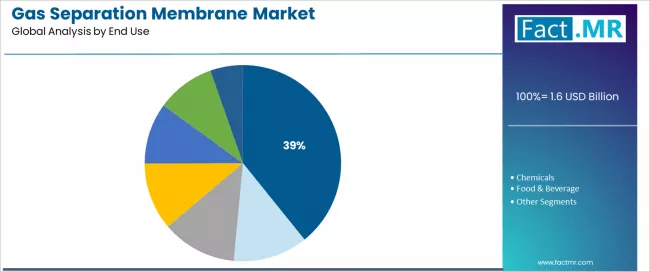
Petrochemicals and oil & gas establish end-use leadership in the gas separation membrane sector with a 39.2% share due to comprehensive gas processing requirements and sustained focus on natural gas treatment, hydrogen recovery, and refinery gas purification that maximize process efficiency while maintaining appropriate product quality standards.
Process engineers prioritize petrochemical applications for natural gas conditioning, refinery hydrogen recovery, and integration with hydrocarbon processing operations that enables coordinated production experiences across multiple process units. The sector benefits from substantial capacity expansion momentum and emission reduction campaigns that emphasize membrane-based separation delivery for cost-effective gas treatment applications.
Natural gas production expansion incorporates membrane separation as standard conditioning protocols for pipeline quality achievement, while hydrogen demand increases recovery system adoption that meets purity requirements and ensures feedstock optimization capabilities.
End-use dynamics include:
- Strong growth in biogas upgrading operations requiring carbon dioxide removal and methane enrichment arrangements
- Increasing adoption in ammonia production facilities for hydrogen purification and synthesis gas conditioning positioning
- Rising integration with carbon capture initiatives for industrial emission reduction and sustainability compliance approaches
How are Chemical Processing Facilities Advancing Specialized Separation Requirements?
Chemical processing facilities capture a substantial end-use share at 21.1% through established production optimization frameworks, process gas recovery capabilities, and integrated purification protocols.
The segment demonstrates specialized separation expertise across diverse chemical populations, with solvent recovery applications and reaction gas conditioning infrastructure gaining traction in efficiency improvement programs while cost reduction frameworks drive continued membrane utilization requiring careful balance between separation performance and capital investment assurance.
What are the Drivers, Restraints, and Key Trends of the Gas Separation Membrane Market?
| Category | Factor | Impact | Why It Matters |
|---|---|---|---|
| Driver | Rising energy efficiency & operational cost reduction (process optimization, sustainability) | ★★★★★ | Energy consciousness enables membrane demand for cost-effective separation; increasing operational efficiency focus drives technology adoption across industrial markets and diverse geographic segments. |
| Driver | Growth in natural gas production and processing (unconventional resources, LNG expansion) | ★★★★★ | Drives demand for reliable gas treatment systems and efficient purification protocols; operators providing economical conditioning gain competitive advantage in energy-focused petrochemical segments. |
| Driver | Environmental regulations & emission control requirements (carbon capture, pollution reduction) | ★★★★☆ | Engineers demand validated separation methods and documented compliance systems; regulatory visibility expanding addressable segments beyond traditional gas processing and conventional separation clientele. |
| Restraint | High capital costs & membrane replacement expenses (system investment, maintenance requirements) | ★★★★☆ | Cost-conscious operators face budget limitations and economic justification constraints, restricting membrane adoption and affecting technology penetration in resource-limited facilities and developing market plants. |
| Restraint | Membrane fouling & performance degradation (contaminant sensitivity, lifespan limitations) | ★★★☆☆ | Facilities face reliability concerns and maintenance limitations; increases operational barriers and affects adoption penetration in contaminated gas streams and challenging process applications. |
| Trend | Hydrogen economy development & clean energy transition (fuel cell applications, renewable hydrogen) | ★★★★★ | Growing industrial emphasis on hydrogen purification and carbon-free energy beyond traditional hydrocarbon processing; hydrogen separation becomes core differentiation strategy for clean energy market positioning. |
| Trend | Mixed matrix membrane innovation (hybrid materials, enhanced selectivity) | ★★★★☆ | Separation technology evolving beyond conventional polymers toward advanced composite protocols; material positioning drives enhanced performance and application versatility in sophisticated industrial environments. |
Analysis of the Gas Separation Membrane Market by Key Countries
The gas separation membrane market demonstrates robust regional growth dynamics with emerging leaders including India (8.7% CAGR) and China (8.3% CAGR) driving expansion through petrochemical manufacturing programs and industrial gas infrastructure development. Strong performers encompass the USA (7.8% CAGR), Saudi Arabia (7.6% CAGR), and Brazil (7.1% CAGR), benefiting from established natural gas processing infrastructure and energy production demographics. Mature markets feature Germany (6.9% CAGR) and Japan (6.4% CAGR), where industrial efficiency normalization and emission control support consistent growth patterns.
Regional synthesis reveals Asian markets leading adoption through comprehensive manufacturing capacity positioning and petrochemical investment expansion, while Western countries demonstrate measured growth potential supported by environmental regulation preferences and hydrogen economy influence. North American markets show solid development driven by shale gas culture integration and advanced separation infrastructure.
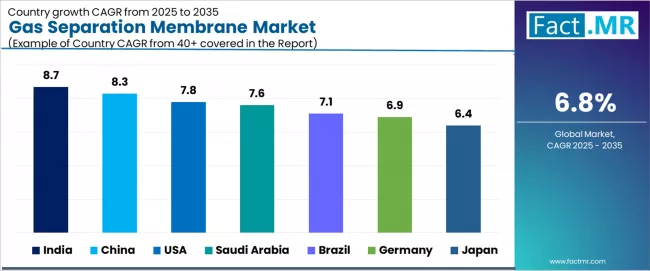
| Region/Country | 2025-2035 Growth | How to win | What to watch out |
|---|---|---|---|
| India | 8.7% | Focus on cost-effective system portfolios | Infrastructure gaps; technical expertise needs |
| China | 8.3% | Lead with manufacturing-scale solutions | Price competition; local manufacturer growth |
| USA | 7.8% | Provide hydrogen separation technologies | Market maturity; technology competition |
| Saudi Arabia | 7.6% | Maintain natural gas processing positioning | Project execution; capability development |
| Brazil | 7.1% | Deliver petrochemical integration solutions | Economic volatility; investment constraints |
| Germany | 6.9% | Push emission control strategies | Conservative adoption; documentation requirements |
| Japan | 6.4% | Offer high-purity applications | Market maturity; cost pressures |
India Drives Fastest Market Growth
India establishes fastest market growth through progressive petrochemical manufacturing expansion and comprehensive industrial gas infrastructure development, positioning gas separation membrane technologies as essential process solutions in refinery complexes and emerging chemical production facilities. The country's 8.7% growth rate reflects rising industrial capacity levels supporting equipment investment and growing energy efficiency awareness that encourage the deployment of membrane separation products in diverse processing settings.
Growth concentrates in major industrial zones, including Gujarat, Maharashtra, and Tamil Nadu, where facilities showcase increasing capacity for international efficiency standard adoption that appeal to cost-conscious operators demanding validated gas treatment and process optimization outcomes.
Indian process engineers are developing standardized separation protocols that combine imported membrane technologies with domestic engineering expertise, including nitrogen generation system expansion and natural gas conditioning programs. Distribution channels through industrial equipment distributors and engineering procurement contractors expand market access, while technical training initiatives support adoption across diverse facility types and industry specialization levels.
China Emerges as Industrial Gas Processing Leader
In regions spanning coastal industrial zones and inland petrochemical parks, chemical companies and refinery operators are adopting advanced gas separation membrane technologies as essential processing tools for production operations, driven by increasing manufacturing scale-up investments and elevation of energy efficiency expectations that emphasize the importance of validated gas purification.
The market holds an 8.3% growth rate, supported by petrochemical capacity expansion and environmental compliance investment that promote membrane adoption for emission reduction applications. Chinese engineers are favoring integrated membrane platforms that provide comprehensive separation performance and operational cost evidence, particularly appealing in industrial clusters where system reliability and economic efficiency represent critical operational factors.
Market expansion benefits from substantial petrochemical facility investment and domestic technology development that enable widespread adoption of evidence-based separation methodologies for diverse gas processing applications. Industry adoption follows patterns established in manufacturing excellence programs, where process system advantages and energy efficiency documentation drive operator confidence and facility competitiveness achievement.
USA Shows Natural Gas Infrastructure Leadership
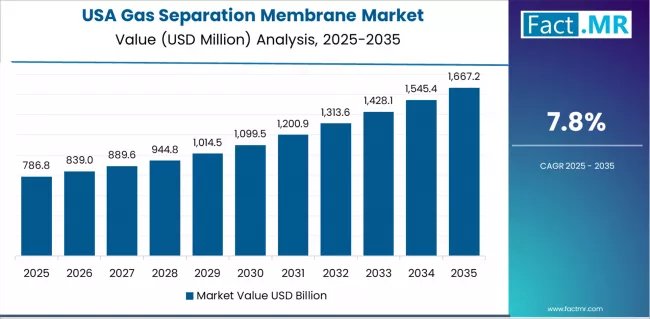
USA establishes natural gas infrastructure leadership through comprehensive shale gas production and established processing ecosystem, integrating gas separation membrane technologies across natural gas plants, refineries, and hydrogen production facilities. The country's 7.8% growth rate reflects established operational efficiency maturity and sophisticated process engineer expertise levels that support widespread deployment of validated membrane products in gas conditioning and purification applications.
Growth concentrates in established energy regions, including Texas, Louisiana, and Pennsylvania, where operators showcase advanced separation technology adoption that appeals to efficiency-focused organizations seeking predictable performance outcomes and comprehensive operational cost reduction.
American process operators leverage established equipment relationships and comprehensive engineering protocol frameworks, including process optimization programs and energy efficiency initiatives that create technology confidence and separation standardization. The market benefits from substantial hydrogen economy development and carbon capture initiatives that encourage premium membrane purchases while supporting continuous innovation investments and performance validation funding.
Saudi Arabia Shows Petrochemical Processing Integration
Saudi Arabia's advanced petrochemical market demonstrates sophisticated gas separation membrane integration with documented efficiency emphasis in natural gas treatment and process gas recovery through specialized refinery complexes and established petrochemical networks.
The country leverages comprehensive hydrocarbon resource base and process optimization approaches to maintain a 7.6% growth rate. Premium petrochemical centers, including Jubail, Yanbu, and Ras Tanura, showcase operational excellence priorities where membrane technologies integrate with established Saudi Aramco cultures and comprehensive processing practices to optimize gas utilization and ensure appropriate product recovery.
Saudi engineers prioritize economic efficiency requirements and comprehensive process integration in membrane implementation, creating demand for proven products with extensive reliability characteristics, including high-temperature performance, corrosion resistance capabilities, and technical support services. The market benefits from established petrochemical mega-project programs and gas monetization strategies that provide differentiation opportunities and alignment with Saudi Vision 2030 industrial diversification objectives.
Brazil Shows Energy Sector Responsiveness
Brazil's developing industrial market demonstrates progressive gas separation membrane adoption with increasing efficiency focus in pre-salt gas processing and ethanol production applications through expanding petrochemical facilities and established biofuel operations. The country maintains a 7.1% growth rate, leveraging offshore gas development and renewable fuel expansion in production environments.
Key industrial regions, including Sao Paulo, Rio de Janeiro, and Bahia, showcase emerging processing priorities where membrane technologies integrate with developing efficiency cultures and expanding separation capabilities to optimize gas treatment and maintain production economics under evolving energy sector requirements.
Brazilian process engineers prioritize cost-effective separation strategies and comprehensive operational efficiency in membrane program development, creating demand for economical products with performance characteristics, including biogas upgrading capabilities, process integration flexibility, and technical implementation guidance. The market benefits from emerging biofuel sectors and growing energy efficiency awareness that provide market development opportunities and support expansion of gas processing services.
Germany Shows Industrial Efficiency Integration
Germany's advanced industrial market demonstrates sophisticated gas separation membrane integration with documented sustainability emphasis in emission control and hydrogen production through specialized chemical facilities and established industrial gas networks. The country leverages rigorous environmental standard principles and evidence-based efficiency approaches to maintain a 6.9% growth rate.
Premium industrial centers, including North Rhine-Westphalia, Bavaria, and Baden-Wurttemberg, showcase environmental compliance priorities where membrane technologies integrate with established German manufacturing cultures and comprehensive emission reduction practices to optimize process efficiency and ensure appropriate environmental performance.
German engineers prioritize sustainability requirements and comprehensive emission documentation in membrane implementation, creating demand for environmentally focused products with extensive performance characteristics, including carbon capture capabilities, energy efficiency data, and comprehensive technical literature. The market benefits from established industrial decarbonization programs and hydrogen strategy implementation that provide differentiation opportunities and compliance with strict German environmental regulations.
Japan Shows Industrial Gas Quality Leadership
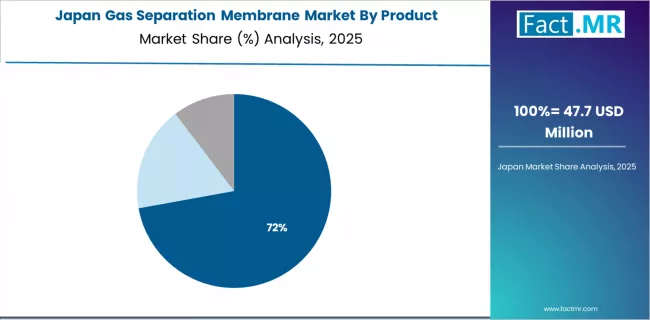
Japan's mature industrial market demonstrates established gas separation membrane integration with documented purity emphasis in semiconductor manufacturing and industrial gas supply through comprehensive chemical facilities and specialized industrial gas networks. The country maintains a 6.4% growth rate, leveraging advanced manufacturing technology heritage and quality-focused industrial cultures in production environments.
Principal industrial regions, including Tokyo, Osaka, and Nagoya areas, showcase quality precision where membrane technologies integrate with established Japanese manufacturing environments and comprehensive purity control practices to optimize product specifications and maintain competitive advantages under demanding quality requirements.
Japanese engineers prioritize high-purity advancement and comprehensive quality assurance in membrane implementation, creating demand for precision-engineered products with extensive purity characteristics, including ultra-high purity nitrogen generation, trace contaminant removal, and technical consultation services. The market benefits from established electronics manufacturing sectors and industrial gas quality standards that provide premium differentiation opportunities and maintain alignment with Japanese industrial specifications.
Europe Market Split by Country
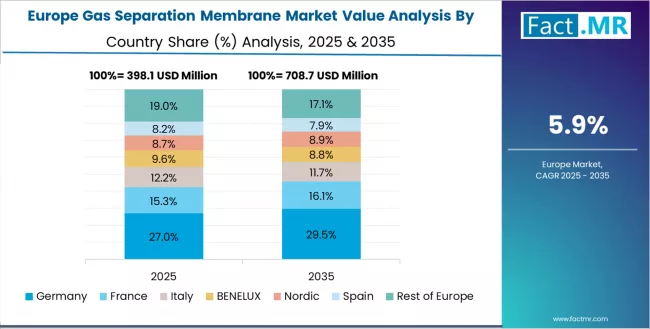
The gas separation membrane market in Europe is projected to grow from USD 0.4 billion in 2025 to USD 0.8 billion by 2035, registering a CAGR of 6.6% over the forecast period. Germany is expected to maintain its leadership position with a 26.8% market share in 2025, supported by its advanced industrial infrastructure and established chemical processing networks.
France follows with USD 0.1 billion, representing 18.9% of the European market in 2025, driven by comprehensive industrial gas integration and petrochemical facility concentration. UK holds USD 0.1 billion with 17.3% market share through established process efficiency acceptance and manufacturing facility density.
Italy commands USD 0.1 billion representing 14.2% share, while Spain accounts for USD 0.0 billion or 11.6% in 2025. The rest of Europe region maintains USD 0.0 billion, representing 11.2% of the European market, attributed to increasing gas separation membrane adoption in Nordic countries and emerging Eastern European industrial sectors implementing efficiency programs.
Competitive Landscape of the Gas Separation Membrane Market
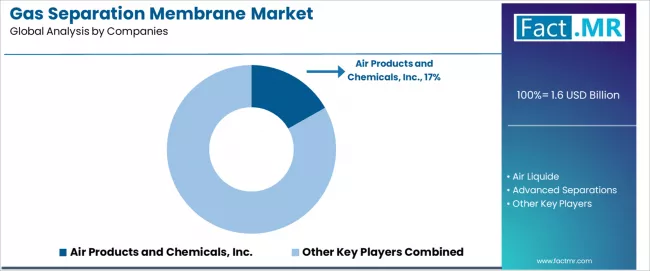
The gas separation membrane market exhibits a moderately consolidated competitive structure with approximately 40-60 active players operating across global industrial gas networks and regional separation technology distribution portfolios. Air Products and Chemicals, Inc. maintains market leadership at a 16.8% share, reflecting strong product portfolio positioning across diverse membrane categories with sophisticated global industrial strategies.
This competitive landscape demonstrates the maturation of gas separation membrane technology, where established players leverage brand recognition advantages, extensive application evidence documentation, and process engineer relationship programs to maintain dominant positions, while emerging advanced material developers and regional membrane manufacturers create niche opportunities through innovative separation offerings and competitive pricing strategies.
Market leadership is maintained through several critical competitive advantages extending beyond manufacturing capabilities and product portfolios. Global distribution networks enable leading players to navigate diverse regulatory requirements and access varied industrial segments including petrochemical plants, refineries, and food processing facilities.
Technical support infrastructure and application engineering program availability represent crucial differentiators in membrane categories, where decades of separation expertise, process integration protocols, and operational reliability frameworks create purchasing preference among quality-focused engineers.
Manufacturing efficiency in polymer processing facilities, supply chain material management, and quality control separate major suppliers from smaller competitors, while comprehensive performance documentation addressing selectivity data, permeability studies, and case references strengthen market position and customer confidence.
The market demonstrates emerging differentiation opportunities in mixed matrix membrane categories and hydrogen separation technologies, where traditional polymeric membrane approaches face competition from innovation-focused entrants offering enhanced performance advantages.
Significant competitive advantages persist in established nitrogen separation categories through comprehensive industrial acceptance portfolios and process integrator relationship depth. Premium positioning strategies with advanced material integration and system optimization capabilities command margin premiums through superior efficiency and operational reliability.
Specialized membrane portfolios combining multiple material technologies with application-specific configurations create comprehensive positioning that justifies higher price points beyond commodity product competition. Integrated solution offerings emphasizing complementary process equipment compatibility, unified technical support, and lifecycle service programs generate brand loyalty and membrane system preferences beyond transactional purchases.
| Stakeholder | What they actually control | Typical strengths | Typical blind spots |
|---|---|---|---|
| Global industrial gas corporations | Comprehensive membrane portfolios; global distribution; application documentation | Brand recognition; performance evidence; engineer relationships; regulatory expertise | Innovation speed; pricing flexibility; niche applications; emerging market customization |
| Specialized membrane companies | Innovation expertise; separation technology; material optimization | Product differentiation; technical sophistication; engineering support; customer loyalty | Market penetration; distribution infrastructure; price competitiveness; geographic coverage |
| Regional equipment manufacturers | Local production; cost optimization; regional distribution; facility proximity | Affordability positioning; delivery speed; local support; cultural understanding | Performance validation; brand recognition; international expansion; advanced materials |
| Material science innovators | Advanced polymers; inorganic materials; mixed matrix membranes; surface modification | Innovation leadership; selectivity profiles; technical differentiation; research partnerships | Industrial relationships; manufacturing scale; application expertise; market awareness |
| Process equipment integrators | System design; turnkey solutions; installation expertise; process integration | Customer relationships; project execution; application knowledge; service quality | Membrane manufacturing; material innovation; technology development; global reach |
Key Players in the Gas Separation Membrane Market
- Air Products and Chemicals, Inc.
- Air Liquide
- Advanced Separations
- Atlas Copco AB
- DIC Corporation
- Evonik Industries AG
- FUJIFILM Corporation
- GENERON
- GMT Membrantechnik GmbH
- JSC Grasys
- Honeywell International Inc.
- Mahler AGS GmbH
- Parker Hannifin Corp
- SLB
- UBE Corporation
Scope of the Report
| Items | Values |
|---|---|
| Quantitative Units (2025) | USD 1.6 billion |
| Product | Polymeric Membranes, Inorganic Membranes, Metallic Membranes |
| Application | Nitrogen Separation, Acid Gas Separation, Oxygen Separation, Hydrogen Separation, Other |
| End Use | Petrochemicals and Oil & Gas, Chemicals, Food & Beverage, Power Generation, Pharmaceuticals, Pollution Control, Other |
| Regions Covered | North America, Europe, Asia Pacific, Latin America, Middle East & Africa |
| Countries Covered | USA, China, Germany, India, Japan, Saudi Arabia, Brazil |
| Key Companies Profiled | Air Products and Chemicals, Inc., Air Liquide, Advanced Separations, Atlas Copco AB, DIC Corporation, Evonik Industries AG, FUJIFILM Corporation, GENERON, GMT Membrantechnik GmbH, JSC Grasys, Honeywell International Inc., Mahler AGS GmbH, Parker Hannifin Corp, SLB, UBE Corporation |
| Additional Attributes | Dollar sales by product and application categories, regional adoption trends across Asia Pacific, North America, and Middle East & Africa, competitive landscape with established industrial gas corporations and specialized membrane companies, engineer preferences for separation methodologies and process protocols, integration with petrochemical facilities and chemical processing organizations, innovations in mixed matrix technologies and advanced material platforms, and development of sophisticated purification systems with enhanced selectivity profiles and comprehensive performance documentation frameworks. |
Gas Separation Membrane Market by Segments
-
Product :
- Polymeric Membranes
- Inorganic Membranes
- Metallic Membranes
-
Application :
- Nitrogen Separation
- Acid Gas Separation
- Oxygen Separation
- Hydrogen Separation
- Other
-
End Use :
- Petrochemicals and Oil & Gas
- Chemicals
- Food & Beverage
- Power Generation
- Pharmaceuticals
- Pollution Control
- Other
-
Region :
- North America
- USA
- Canada
- Mexico
- Europe
- Germany
- France
- UK
- Italy
- Spain
- Rest of Europe
- Asia Pacific
- China
- India
- Japan
- South Korea
- ASEAN
- Australia & New Zealand
- Rest of Asia Pacific
- Latin America
- Brazil
- Rest of Latin America
- Middle East & Africa
- Saudi Arabia
- GCC Countries
- South Africa
- Rest of Middle East & Africa
- North America
Table of Content
- Executive Summary
- USA Market Outlook
- Demand to side Trends
- Supply to side Trends
- Technology Roadmap Analysis
- Analysis and Recommendations
- Market Overview
- Market Coverage / Taxonomy
- Market Definition / Scope / Limitations
- Market Background
- Market Dynamics
- Drivers
- Restraints
- Opportunity
- Trends
- Scenario Forecast
- Demand in Optimistic Scenario
- Demand in Likely Scenario
- Demand in Conservative Scenario
- Opportunity Map Analysis
- Product Life Cycle Analysis
- Supply Chain Analysis
- Investment Feasibility Matrix
- Value Chain Analysis
- PESTLE and Porter’s Analysis
- Regulatory Landscape
- Regional Parent Market Outlook
- Production and Consumption Statistics
- Import and Export Statistics
- Market Dynamics
- USA Market Analysis 2020 to 2024 and Forecast, 2025 to 2035
- Historical Market Size Value (USD Million) Analysis, 2020 to 2024
- Current and Future Market Size Value (USD Million) Projections, 2025 to 2035
- Y to o to Y Growth Trend Analysis
- Absolute $ Opportunity Analysis
- USA Market Pricing Analysis 2020 to 2024 and Forecast 2025 to 2035
- USA Market Analysis 2020 to 2024 and Forecast 2025 to 2035, By Product
- Introduction / Key Findings
- Historical Market Size Value (USD Million) Analysis By Product, 2020 to 2024
- Current and Future Market Size Value (USD Million) Analysis and Forecast By Product, 2025 to 2035
- Polymeric Membranes
- Inorganic Membranes
- Metallic Membranes
- Y to o to Y Growth Trend Analysis By Product, 2020 to 2024
- Absolute $ Opportunity Analysis By Product, 2025 to 2035
- USA Market Analysis 2020 to 2024 and Forecast 2025 to 2035, By Application
- Introduction / Key Findings
- Historical Market Size Value (USD Million) Analysis By Application, 2020 to 2024
- Current and Future Market Size Value (USD Million) Analysis and Forecast By Application, 2025 to 2035
- Nitrogen Separation
- Acid Gas Separation
- Oxygen Separation
- Hydrogen Separation
- Other
- Y to o to Y Growth Trend Analysis By Application, 2020 to 2024
- Absolute $ Opportunity Analysis By Application, 2025 to 2035
- USA Market Analysis 2020 to 2024 and Forecast 2025 to 2035, By End Use
- Introduction / Key Findings
- Historical Market Size Value (USD Million) Analysis By End Use, 2020 to 2024
- Current and Future Market Size Value (USD Million) Analysis and Forecast By End Use, 2025 to 2035
- Petrochemicals and Oil & Gas
- Chemicals
- Food & Beverage
- Power Generation
- Pharmaceuticals
- Pollution Control
- Other
- Y to o to Y Growth Trend Analysis By End Use, 2020 to 2024
- Absolute $ Opportunity Analysis By End Use, 2025 to 2035
- USA Market Analysis 2020 to 2024 and Forecast 2025 to 2035, By Region
- Introduction
- Historical Market Size Value (USD Million) Analysis By Region, 2020 to 2024
- Current Market Size Value (USD Million) Analysis and Forecast By Region, 2025 to 2035
- USA
- Market Attractiveness Analysis By Region
- USA Market Analysis 2020 to 2024 and Forecast 2025 to 2035, By Country
- Historical Market Size Value (USD Million) Trend Analysis By Market Taxonomy, 2020 to 2024
- Market Size Value (USD Million) Forecast By Market Taxonomy, 2025 to 2035
- By Country
- By Product
- By Application
- By End Use
- Market Attractiveness Analysis
- By Country
- By Product
- By Application
- By End Use
- Key Takeaways
- Market Structure Analysis
- Competition Dashboard
- Competition Benchmarking
- Market Share Analysis of Top Players
- By Regional
- By Product
- By Application
- By End Use
- Competition Analysis
- Competition Deep Dive
- Air Products and Chemicals, Inc.
- Overview
- Product Portfolio
- Profitability by Market Segments (Product/Age /Sales Channel/Region)
- Sales Footprint
- Strategy Overview
- Marketing Strategy
- Product Strategy
- Channel Strategy
- Air Liquide
- Advanced Separations
- Atlas Copco AB
- DIC Corporation
- Evonik Industries AG
- FUJIFILM Corporation
- GENERON
- GMT Membrantechnik GmbH
- JSC Grasys
- Honeywell International Inc.
- Mahler AGS GmbH
- Parker Hannifin Corp
- SLB
- UBE Corporation
- Air Products and Chemicals, Inc.
- Competition Deep Dive
- Assumptions & Acronyms Used
- Research Methodology
List Of Table
- Table 1: USA Market Value (USD Million) Forecast by Region, 2020 to 2035
- Table 2: USA Market Value (USD Million) Forecast by Product, 2020 to 2035
- Table 3: USA Market Value (USD Million) Forecast by Application, 2020 to 2035
- Table 4: USA Market Value (USD Million) Forecast by End Use, 2020 to 2035
- Table 5: USA Market Value (USD Million) Forecast by Country, 2020 to 2035
- Table 6: USA Market Value (USD Million) Forecast by Product, 2020 to 2035
- Table 7: USA Market Value (USD Million) Forecast by Application, 2020 to 2035
- Table 8: USA Market Value (USD Million) Forecast by End Use, 2020 to 2035
List Of Figures
- Figure 1: USA Market Pricing Analysis
- Figure 2: USA Market Value (USD Million) Forecast 2020 to 2035
- Figure 3: USA Market Value Share and BPS Analysis by Product, 2025 and 2035
- Figure 4: USA Market Y to o to Y Growth Comparison by Product, 2025 to 2035
- Figure 5: USA Market Attractiveness Analysis by Product
- Figure 6: USA Market Value Share and BPS Analysis by Application, 2025 and 2035
- Figure 7: USA Market Y to o to Y Growth Comparison by Application, 2025 to 2035
- Figure 8: USA Market Attractiveness Analysis by Application
- Figure 9: USA Market Value Share and BPS Analysis by End Use, 2025 and 2035
- Figure 10: USA Market Y to o to Y Growth Comparison by End Use, 2025 to 2035
- Figure 11: USA Market Attractiveness Analysis by End Use
- Figure 12: USA Market Value (USD Million) Share and BPS Analysis by Region, 2025 and 2035
- Figure 13: USA Market Y to o to Y Growth Comparison by Region, 2025 to 2035
- Figure 14: USA Market Attractiveness Analysis by Region
- Figure 15: USA Market Incremental Dollar Opportunity, 2025 to 2035
- Figure 16: USA Market Value Share and BPS Analysis by Country, 2025 and 2035
- Figure 17: USA Market Value Share and BPS Analysis by Product, 2025 and 2035
- Figure 18: USA Market Y to o to Y Growth Comparison by Product, 2025 to 2035
- Figure 19: USA Market Attractiveness Analysis by Product
- Figure 20: USA Market Value Share and BPS Analysis by Application, 2025 and 2035
- Figure 21: USA Market Y to o to Y Growth Comparison by Application, 2025 to 2035
- Figure 22: USA Market Attractiveness Analysis by Application
- Figure 23: USA Market Value Share and BPS Analysis by End Use, 2025 and 2035
- Figure 24: USA Market Y to o to Y Growth Comparison by End Use, 2025 to 2035
- Figure 25: USA Market Attractiveness Analysis by End Use
- Figure 26: USA Market - Tier Structure Analysis
- Figure 27: USA Market - Company Share Analysis
- FAQs -
How big is the gas separation membrane market in 2025?
The global gas separation membrane market is estimated to be valued at USD 1.6 billion in 2025.
What will be the size of gas separation membrane market in 2035?
The market size for the gas separation membrane market is projected to reach USD 3.1 billion by 2035.
How much will be the gas separation membrane market growth between 2025 and 2035?
The gas separation membrane market is expected to grow at a 6.8% CAGR between 2025 and 2035.
What are the key product types in the gas separation membrane market?
The key product types in gas separation membrane market are polymeric membranes, inorganic membranes and metallic membranes.
Which application segment to contribute significant share in the gas separation membrane market in 2025?
In terms of application, nitrogen separation segment to command 41.6% share in the gas separation membrane market in 2025.